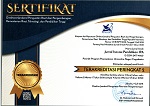The Implementation of Nucu Ngoruh in The Traditional Marriage of The Dayak Siang Tribe
Abstract
This study aimed to analyze the implementation, support, and inhibiting factors of nucu ngoruh in Dayak Siang traditional weddings. A qualitative method with observation, interviews, and documentation was utilized to get the research finding. The implementation of nucu ngoruh in traditional Dayak Siang marriages in Saripoi Village consisted of two versions. The first version of the wedding procession was making pondong, making lawang sakepeng, making hompong, and the marriage contract process. The second version of the marriage procession was pantan pulut, pali manasai, ngiap or kandan ngiap, second hompong and third hompong, which includes hompong balanga, lawang sakepeng, Manasai dance, hompong human/female, and the bride and groom sat side by side on the Mura gong. The supporting factor for nucu ngoruh was that indigenous peoples highly respected the provisions of social and divine values, so indigenous people adjusted to the provisions for the preparation of traditional goods, and the procession of traditional marriages might also be under customary rules. Finally, there were four inhibiting factors for nucu ngoruh. First, the groom was not ready either physically or mentally. The second was the lack of financial support provided. The third was the absence of people who mastered the art of sculpture was make statues to complete the implementation of the traditional Dayak Siang wedding. Fifth, there was no written text or manual procedure for implementing the traditional Dayak Siang wedding procession.
Keywords
Full Text:
PDFReferences
Abbas, I. (2013). Pappaseng: Kearifan Lokal Manusia Bugis yang Terlupakan. Jurnal Ilmu-Ilmu Sosial dan Humaniora, 15(3), 272-284.
Abdullah, S., Qureshi, H., & Quayes, S. (2015). The Adverse Effect of Child Marriage on Women's Economic Well Being in Bangladesh-Can Microfinance Help? The Journal of Developing Areas, 49(4), 109-125.
Amin, S., & Das, M. B. (2013). Marriage Continuity and Change in Bangladesh. New Delhi: Orient Blackswan.
Baldacchino, J. P. (2008). Eros and Modernity: Convulsions of the Heart in Modern Korea. Asian Studies Review, 32(1), 99-122.
Bicchieri, C., Jiang. T., & Lindemans, J. W. (2014). A Social Norms Perspective on Child Marriage: The General Framework. Philadelphia: University of Pennsylvania.
Coontz, S. (2005). Marriage a History: How Love Conquered Marriage. New York: The Penguin Group.
Derne, S. (2005). The (Limited) Effect of Cultural Globalization in India: Implications for Culture Theory. Poetics, 33(1), 33-47.
El-Saharty, S., Zunaid-Ahsan, K., & May, J. F. (2014). Population, Family Planning, and Reproductive Health Policy Harmonization in Bangladesh. Washington: The International Bank for Reconstruction and Development.
Hunnicutt, G. (2009). Varieties of Patriarchy and Violence Against Women: Resurrecting “Patriarchy” as a Theoretical Tool. Violence Against Women, 15(5), 553-573.
Kambarami, M. (2006). Femininity, Sexuality and Culture: Patriarchy and Female Subordination in Zimbabwe. Africa Regional Sexuality Resource Centre.
Lai, V., Sheriff, S. M., Sam, J., & Bandy, A. S. (2018). Child Marriage: Its Relationship with Religion, Culture and Patriarchy. Kuala Lumpur: SIS Forum (Malaysia) Berhad, Asian-Pacific Resource and Research Center for Women.
Medora, N. P. (2003). Mate Selection in Contemporary India: Love Marriages v/s Arranged Marriages. New York: Sage Publishing.
Melluish, S. (2014). Globalization, Culture and Psychology. International Review of Psychiatry, 26(5), 538-543.
Netting, N. S. (2010). Marital Ideoscapes in 21st-Century India: Creative Combinations of Love and Responsibility. Journal of Family Issues, 31(6), 707-726.
Nurdiyanawati, L. W., & Hamidah, S. (2019). Batasan Perjanjian Perkawinan yang Tidak Melanggar Hukum, Agama, dan Kesusilaan. Jurnal Ilmiah Pendidikan Pancasila dan Kewarganegaraan, 4(1), 101-108.
Peterson, B. E., Kim, R., McCarthy, J. M., Park, C. J., & Plamondon, L. T. (2011). Authoritarianism and Arranged Marriage in Bangladesh and Korea. Journal of Research in Personality, 45(6), 622-630.
Rathor, S. R. (2011). Importance of Marriage for Asian Indian Women in the US: An Exploratory Study (Doctoral Dissertation). Rutgers University-Graduate School of Applied and Professional Psychology.
Republik Indonesia. (1974). Undang-Undang Nomor 1 Tahun 1974 tentang Perkawinan. Lembaran Negara Republik Indonesia Tahun 1974 Nomor 1. Tambahan Lembaran Negara Republik Indonesia Nomor 3019.
Sampath, G. (2017). Indian Youth Look Modern, but Inclined to Conservatism and Intolerance: Survey. The Hindus.
Sandarupa, S. (2014). Kebudayaan Toraja Modal Bangsa, Milik Dunia. Jurnal Ilmu-Ilmu Sosial dan Humaniora, 16(1), 1-9.
Shahen, A., Hossain, B., & Jahan, N. (2019). Globalization and Bangladesh: An Analysis from a Cultural Perspective. Journal of Humanities and Social Science, 25(1), 32-41.
Sharangpani, M. (2010). Browsing for Bridegrooms: Matchmaking and Modernity in Mumbai. Indian Journal of Gender Studies, 17(2), 249-276.
Sofyan, A. N., Sofianto, K., Sutirman, M., & Suganda, D. (2021). Regenerasi Kearifan Lokal Kesenian Lebon sebagai Budaya Leluhur Pangandaran, Jawa Barat. Jurnal Ilmu-Ilmu Sosial dan Humaniora, 23(2), 158-166.
Soy, N. F., & Sahoo, H. (2016). Marriage Arrangements and Customs in India. Social Science Spectrum, 2(4), 248-262.
Talbani, A., & Hasanali, P. (2000). Adolescent Females Between Tradition and Modernity: Gender Role Socialization in South Asian Immigrant Culture. Journal of Adolescence, 23(5), 615-627.
Wahhaj, Z. (2015). A Theory of Child Marriage. School of Economics, University of Kent.
Walle, T. M. (1998). As Good As a Man Can Be: Some Thoughts on Love, Marriage and Masculinity. Fourth Nordic Conference on Middle Eastern Studies: The Middle East in a Globalized World.
Zahid, D. (2007). Impact of Cultural Globalization on the Upper Class Youth in Dhaka City: A Sample Study. Bangladesh e-Journal of Sociology, 4(2), 45-55.
DOI: http://dx.doi.org/10.17977/um019v7i2p387-394
Refbacks
- There are currently no refbacks.
Copyright (c) 2022 Jurnal Ilmiah Pendidikan Pancasila dan Kewarganegaraan

This work is licensed under a Creative Commons Attribution 4.0 International License.
View My Stats











